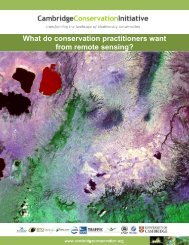CONSERVING BIODIVERSITY & DELIVERING ECOSYSTEM SERVICES
conserving biodiversity & delivering ecosystem services
conserving biodiversity & delivering ecosystem services
You also want an ePaper? Increase the reach of your titles
YUMPU automatically turns print PDFs into web optimized ePapers that Google loves.
The Ministry of Local Development is responsible for the<br />
implementation of local development programmes and<br />
projects through decentralised local governance systems. The<br />
Local Self Governance Act 1999 entrusts local bodies to make<br />
decisions which will affect the lives of the people. The Act also<br />
empowers local bodies such as District Development<br />
Committees (DDC) and Village Development Committees<br />
(VDC) to manage natural resources within their jurisdiction<br />
and mobilise both human and financial resources. However,<br />
there has been overlap of roles and responsibilities with other<br />
Government line agencies in the management and use of<br />
resources, and this has sometimes resulted in difficulty in<br />
coordinating effective management of biodiversity and<br />
ecosystem services at the site level. One example is the<br />
Jagdishpur Reservoir Important Bird Area (IBA), which is also a<br />
Ramsar Site, and which is managed by the District Forest<br />
Office and the District Irrigation Office for completely<br />
different purposes.<br />
VDC members can make important decisions about the local use<br />
of natural resources. These members attend a stakeholder<br />
workshop at Rara National Park to discuss the use of resources by<br />
different people (David Thomas)<br />
Legislation, policies and plans—relevant to conserving<br />
biodiversity and delivering ecosystem services—in Nepal<br />
Enactment of National Park and Wildlife Conservation Act, 1973<br />
National Park and Wildlife Conservation Rules, 1974<br />
The National Forestry Policy (NFP),1976<br />
Leased Forest Rules, 1978<br />
Watershed Conservation Act,1982<br />
King Mahendra Trust for Nature Conservation Act, 1982<br />
Soil and Watershed Conservation Regulation, 1985<br />
National Conservation Strategy, 1987<br />
Nepal Environmental Policy and Action Plan (NEPAP), 1993<br />
Forestry Policy, 1992<br />
Hydropower Development Policy, 1992<br />
Industrial Policy, 1992<br />
National Shelter Policy, 1996<br />
Buffer Zone Management Regulation, 1996<br />
National Solid Waste Management Policy, 1996<br />
Environment Protection Act, 1996<br />
Environmental Protection Rules, 1997<br />
Buffer Zone Management Guidelines, 1999<br />
Formulation of Sustainable Development Agenda for Nepal<br />
(SDAN), 2002<br />
Nepal Biodiversity Strategy, 2002<br />
Nepal Biodiversity Strategy Implementation Plan, 2006–2010<br />
Water Resources Strategy, 2002<br />
National Wetland Policy, 2003<br />
Leasehold Forestry Policy Guidelines, 2003<br />
National Action Program on Land Degradation and<br />
Desertification, 2004<br />
National Agricultural Policy, 2004<br />
Community Forestry Guidelines, 1996 revised in 2002 and 2005<br />
National Water Plan 2005<br />
Agro-biodiversity Policy, 2007<br />
National Adaptation Programme of Action (NAPA), 2010<br />
Climate Change Policy, 2011<br />
Water Resources of Nepal-Climate Change, 2011<br />
The Ministry of Local Development and local bodies allocate<br />
budgets to implement a wide range of local development<br />
initiatives concerned with, for example, drinking water, rural<br />
roads, irrigation, micro hydroelectricity and other communityidentified<br />
small-scale projects. The local bodies also generate<br />
income from natural resources within their jurisdiction.<br />
However, many of the projects do not consider negative<br />
impacts on the environment and the values of ecosystem<br />
services which may be lost.<br />
Moving to a more sustainable future<br />
Attaining the right balance between use and<br />
conservation is always challenging but nonetheless<br />
necessary. The following are some proposed solutions to<br />
remove barriers to moving in this direction:<br />
■ A stronger policy commitment and growing<br />
realisation among planners on the need for<br />
integrating environment and development<br />
■ More coordinated policy-making taking into account<br />
all the international conventions, facilitating<br />
environmental standards, mainstreaming<br />
environmental issues in development programs, and<br />
monitoring compliance<br />
■ A growing recognition of the importance of a multistakeholder<br />
approach in environmental planning and<br />
management<br />
■ Strengthening, expanding and improving good<br />
practices like community forestry to make them more<br />
inclusive, integrated and sustainable<br />
■ Controlling unsustainable commercial exploitation of<br />
benefits from ecosystem goods and services, thereby<br />
putting people and the planet before profit<br />
SOURCE Drawn from NPC (2011) Nepal Status Paper—United Nations Conference<br />
on Sustainable Development 2012 (Rio+20): Synopsis. Kathmandu: National<br />
Planning Commission, Government of Nepal.




